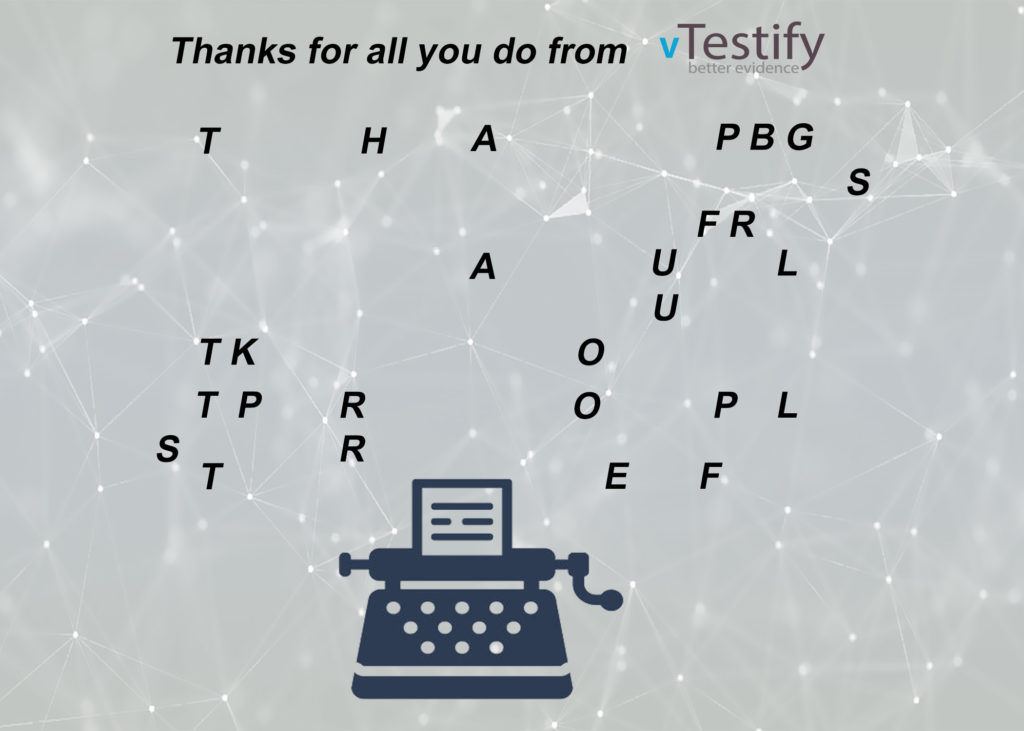Court Reporting Technology Through History
As a celebration of Court Reporting and Captioning Week, we decided to take a dive into how technology has assisted in the evolution of the court reporting industry over the last two centuries. Court reporting is a highly technical industry that has remained on the cutting-edge of technology since its inception. The first instance of shorthand transcription can be traced all the way back to 63 BC when Marcus Tullius Tiro was expected to transcribe the speeches made by famed philosopher, Cicero. His system held fast until roughly 1100 AD. In 1180, the first shorthand system was developed for English speakers, but was not widely used until the late 1800s. Stenography was then brought to the US in the late 19th Century by John Robert Gregg who created his own shorthand system and opened the first two schools in Boston and Chicago.

Shorthand was the gold standard when creating accurate records until the early 20th century. Miles Bartholomew introduced the first shorthand machine in 1870. While it was not widely received, he understood the need to advance the industry in a way that could continue to grow. He wrote, “The old prejudices against machine stenography are giving way to confidence in, and acknowledgement of, its superiority over the pen, and the tide of public favor is rapidly rising in the front.” The first commercially produced stenotype machine was not released until 1911 with the introduction of the Ireland Stenotype Shorthand Machine. It did not emerge into the mainstream until 1914 when it was demonstrated at the National Shorthand Reporters Association speed contest where it consistently beat out seasoned pen writers with a 99% accuracy.
The 1960s welcomed a new type of stenographic writer. This machine eliminated the need to rely on paper notes and would allow the machine to connect to a tape recorder and had a magnetic tape that allowed for computer translations. By 1987, the first machine was released that allowed steno notes to be transferred to a floppy disc and translated on a computer. As technology exploded in the early 90s the Stentura was developed, which had the first of its kind LCD screen that could display steno or translated notes into English. As technology continued to improve, more and more court reporters ditched their paper notes in favor for machines that would sync to their computers and allow them to write cleaner, and produce transcripts much faster than translating paper notes into a typewriter. The early 2000s brought forward additional technology which would allow attorneys to connect into a reporters feed to view Real Time Streaming.
Prior to the COVID-19 pandemic, remote depositions were incredibly rare and often came with a multitude of difficulties. The pandemic forced professionals of all industries to reevaluate their work and see what remote work would look like for them. This new remote world made remote depositions mainstream, enabling court reporters to take multiple depositions a day without having to leave their homes. While this advancement brought many benefits, it also brought with it a whole new list of challenges for court reporters. Crosstalk was now something that could not be managed effectively as the words of each participant would blend into one audio stream. Not every participant would appear in a quiet environment, which would create distracting background noises that make it difficult for the court reporter to create an accurate transcript. Court reporters also were often expected to create an accurate record while also acting as a host, marking exhibits, and moving participants in and out of break-out rooms. It was clear that remote depositions were going to be the future of litigation, so it was imperative that a platform was created that tailored to the needs of the court reporter.
vTestify recognized the need in the industry to create a platform that would allow the court reporter to do what they do best, create a verbatim record. The platform utilizes proprietary noise cancellation and speech diarization to address the court reporters concerns about crosstalk and background noises. This allows the court reporter to review each participants audio independently after the deposition ensuring a clean and accurate transcript without needing to hook up microphones and recording devices to their computers. vTestify took it a step further by simplifying exhibit marking and allowing court reporters access to the exhibits immediately following a proceeding. This enabled the court reporter to focus on the testimony during the deposition and access the material they need immediately following the deposition without having to email parties and request documents be emailed to them. Self-service breakout rooms were also built into the platform allowing the reporter to step away from acting as a deposition “host” and allowing them to focus on making an accurate record.
This year, we celebrate the advancements in the court reporting industry and all the hard work put forth by stenographers and captioners through the years. As the world continues to advance, we believe the court reporting industry will follow suit and we plan to continue to grow and develop tools to enable court reporters to transition into remote work efficiently and stronger than ever.
Happy Court Reporting & Captioning Week!
